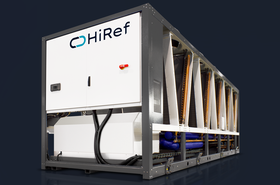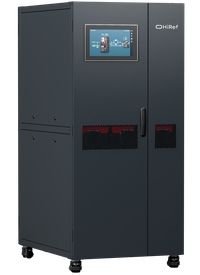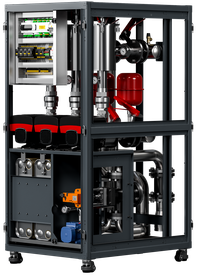The advent of AI has exponentially increased the demand for high-density computing solutions – applications that once required 5-20kW now need up to 150-200kW. Traditional air cooling systems can no longer handle these overwhelming power loads.
In a talk with DCD, Matteo Faccio, CTO at HiRef, discusses the industry’s shift towards liquid cooling solutions to effectively manage the heat produced by these high-density servers.
Cooling challenges in high-density computing
Predicting future cooling needs remains a daunting task due to customer uncertainties surrounding the types of devices to install. Liquid cooling, be it direct-to-chip or immersion, presents significant advantages such as enhanced efficiency, reduced energy consumption, and heightened sustainability. However, despite these benefits, liquid cooling systems still transfer a notable portion of heat to the air, necessitating hybrid cooling solutions.
Evolution of liquid cooling
In the last few years, HiRef has accelerated its project, focusing on developing dedicated and optimized solutions for liquid cooling. Key advancements include the HiNode cooling management system (CMS), which addresses the challenges of high-density computing by optimizing the balance between liquid-cooled and air-cooled energy.
Faccio emphasizes that the HiNode system also enables customers to repurpose waste heat for industrial applications, district heating, and other functions that traditionally use methane to generate heat, such as hospitals, greenhouses, and vertical farms:
“By actively employing heat reuse mechanisms, data center owners can simultaneously improve the sustainability of their site and become part of a new business model, whereby they not only manage data but are also energy providers.”
Real-world implementation and efficiency gains
One of the major challenges when designing data centers is anticipating end-of-life options and accurately predicting the nominal heat load from the beginning. This unpredictability often leads to a disconnect between projected and actual heat demands. For instance, a system designed for 1MW might only require 150kW in reality.
Liquid cooling intensifies this challenge due to fluctuating cooling demands; as servers process large amounts of data, energy demand, and heat rejection peak, then drop drastically when idle. Designing a system capable of responding instantly to these fluctuations remains a formidable task, to which Faccio can relate:
“The most daunting aspect is crafting a system that can react instantaneously to a request, and revert to standby in another couple of seconds.”
Impact of AI on the HVACR sector
AI profoundly influences the heating, ventilation, air conditioning, and refrigeration (HVACR) sector, particularly in cooling management and data center design. Currently, data centers grapple with a fixed quote of power, but rising power demands have spurred on the emergence of smaller-scale, high-density data centers within urban areas.
More compact data centers can be strategically deployed within cities, closer to end-users, offering heightened operational efficiency by minimizing the distance between data processing and consumption points.
According to HiRef, by increasing power density, these smaller data centers can save around 70 percent of their physical footprint compared to their traditional counterparts with equivalent power capacities.
One notable trend in the evolution of cooling system architecture is the growing adoption of dry coolers to manage cooling production.
This trend encompasses the integration of novel cooling units such as CDUs (cooling distribution units), alongside the resurgence of established technologies like rear door heat exchangers, which are experiencing renewed popularity after limited expansion in the past.
Sustainability contributions of liquid cooling
Liquid cooling offers significant sustainability gains and surpasses traditional air cooling methods in efficiency. By capturing heat directly at its source, liquid cooling allows operation at higher temperatures within the cooling loop. This facilitates the use of free cooling techniques, leveraging ambient air for cooling without resorting to additional energy-intensive processes. Moreover, the captured heat can be reused, further enhancing energy efficiency and sustainability.
One crucial point to consider, however, is the type of liquid used for cooling. With chemical producers now entering this market, the choice of cooling liquids, particularly those used for immersion cooling, is paramount for sustainability. Careful selection of cooling liquids is essential to mitigate potential environmental challenges associated with their use.
Company values align with the push for innovation
Most would agree that bringing new, vibrant perspectives into a company’s ethos can profoundly shape its sustainability outlook. HiRef nurtures a strong partnership with the University of Padua, with approximately 90 percent of its engineers originating from there, many of whom have honed their skills through thesis projects conducted with the company. Faccio recalls how HiRef embraces youthful ideas and perspectives, aspiring to develop more sustainable solutions, and reinforcing its own ethical and sustainability objectives:
“Young talents bring a fresh perspective and are inherently more attuned to sustainability and environmental responsibility compared with previous generations. They think about the world in different terms, prioritizing sustainable practices and innovative solutions. This fresh thinking is incredibly beneficial for our company, not just in terms of profitability but in enhancing our products and solutions to better serve our customers and the environment.”
Behind the scenes at HiRef’s R&D department
HiRef’s approach to R&D is heavily supported by its strong collaboration with the University of Padua, facilitated by its engineers and on-site labs:
“We have specialized labs dedicated to thermodynamic and low-temperature applications, data centers, and acoustic studies. These labs serve as a practical playground where engineers can apply theoretical knowledge to real-world applications. This comprehensive R&D strategy enables us to consistently develop and market the best possible units,” illustrates Faccio.
The rapid technological shifts driven by AI make it challenging to predict future needs precisely. In terms of product design, HiRef is actively engaged in capturing and implementing new technologies to stay ahead, emphasizing robust software logic that controls the hardware.
One major challenge with liquid cooling is the lack of redundancy compared with air cooling systems. If an air conditioner fails, others can still maintain cooling, albeit less efficiently. With liquid cooling, a failure in the distribution system can require immediate shutdown to prevent damage.
Therefore, HiRef’s R&D department is focused on developing redundant and reliable systems that can match the reliability of air cooling solutions achieved over the past 15-20 years:
“By prioritizing robust software control and redundancy in our designs, we ensure that our products remain effective and reliable throughout their lifecycle, adapting to the rapid technological changes driven by AI and other innovations.”
Vision for the future of liquid cooling
Sustainability has become a major focus for customers, who now request detailed environmental product documentation, including CO2 footprint and total lifecycle analysis. At the same time, the data center industry faces intense scrutiny due to its high energy consumption. Faccio addresses the common misconception that data centers are inherently detrimental to the environment, emphasizing that society’s reliance on continuous connectivity and data availability makes these data centers indispensable:
“HiRef’s goal is to provide sustainable and reliable solutions that maximize efficiency. This means not only reducing energy usage but also designing our cooling solutions to meet the specific demands of each data center. We strive to balance efficiency and effectiveness, ensuring our systems operate optimally without compromising performance.”
What’s next for cooling technology?
Performance in cooling units is largely determined by the software that manages complex systems, including cooling production, distribution, temperature control, and waste heat management. Faccio notes that without effective software management, even the most efficient units on paper can result in wasted resources and suboptimal performance:
“Looking ahead, our roadmap includes further advancements in this integrative software approach. We aim to enhance how our systems operate as a cohesive whole, ensuring that all elements work together efficiently. This holistic management is key to maximizing sustainability and efficiency.”
In summary, while implementing liquid cooling may be challenging, hybrid solutions are necessary for companies looking to future-proof their data center. HiRef’s goals are based on a commitment to developing adaptable systems that transition seamlessly from air cooling to liquid cooling, accommodating evolving customer demands and technological advancements.
For more information visit hiref.com.
More from HiRef
-

Sponsored More than just a load of hot air
How HiRef has evolved from cooling data centers to championing the reuse of waste heat
-

Sponsored HiRef: Making air conditioning cool
How close ties with Academia fosters innovation in sustainable data center cooling


